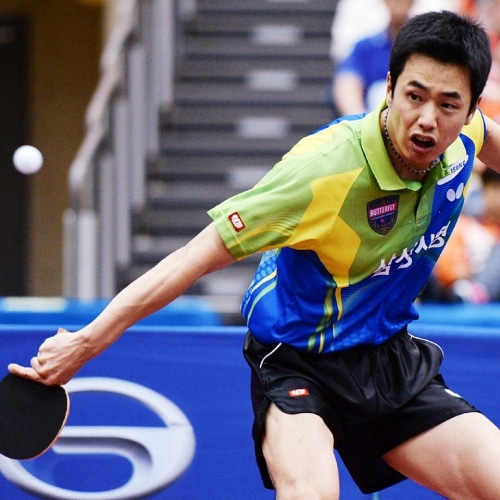In table tennis, as in life, some things you do once and never forget, and other things you have to keep relearning the hard way. This two-minute tip is one of the latter variety for me!
Table of Contents
ToggleDefenders – Deception is Vital
If you are a defensive player, don’t forget that deception is one of the most potent weapons in your arsenal. When you stop sneakily varying the spin on your chops, you become a simple retriever instead of a wily defender, and your results will suffer.

As a defender, there are two scenarios that I find incredibly satisfying:
- When I manage to put so much backspin on the ball that my opponent hits the ball into the bottom of the net; and
- When I manage to float the ball while making it look like a heavy chop, so my opponent misses the table by several feet.
For a defender like myself, these are the equivalent of an attacker hitting that big power loop for a winner – a killer shot.
Don’t Get Tunnel Vision.
But just like an attacker can get fixated on trying to hit winners from all over the court, it’s easy for a defender to get carried away and start trying to win all his points from these same two techniques.
It is a mistake because you become focused on performing only your defensive game’s two extremes – heavy spin and no spin. You forget that you should be playing deceptively on all your other strokes as well. It’s the continual use of different amounts of wrist snap, varying swing speeds, slightly different contact angles, and changes in the height of your chops that all set up the effectiveness of these two killer shots.
Remember also that while watching your opponent’s shot sail several feet off the end off the table or bury itself into the bottom of the net is very gratifying, you still win the point if your opponent misses the table by half an inch, or if the ball clips the top of the net and falls back on his side. Proper use of all your deceptive techniques during the rally will increase your opponent’s chance to make a small mistake in reading the spin, which is often just enough to win the point. In this case, especially – size doesn’t matter!
Be a Defender – Not a Retriever
A defender is a backspin player who is continually attempting to deceive his opponent with variations in his stroke, adjusting his use of wrist, swing speed, racket angle, pace, spin, and ball height to attempt to force mistakes from his attacking opponent. A good defender is tough to play against because not only does the ball keep coming back, but it always comes back differently while looking similar, forcing the attacker to concentrate hard on reading the defender’s shot.
A retriever is a backspin player who simply returns the ball repeatedly, with little or no attempt at deception. A good attacker will soon become very comfortable knowing what spin is on the ball and take control of the match.
A defender who gets caught up trying to win points only by chopping heavily or floating the ball isn’t using all the tricks up his sleeve and becomes much more comfortable to play against, effectively turning himself into a retriever.
Remember, as a defensive player; you have several ways to deceive your opponent and win the point. While some of them are more flashy than others, all of them are important, and you should be making full use of them throughout your rallies. Don’t let the lure of the killer shot make you a one-trick wonder!
Why Not Many People Play Defender Table Tennis
There are many offensive table tennis players, and very few defensive players. It is for the reason that it is a difficult path to play defender. You need to change your game’s fundamentals and skill, which is partly the expression of your character, your perception, and your views.

Defending is not so cool
The defender lives partly on the mistakes of the opponent. Also, they need to be chased around the table as the cat tracks a mouse. You even have to bring about this situation in a controlled manner and find out if you have a safe and intelligent player that can be a trainer to train your defending skill. Then one has as a defender stereotype with most pimples on the RH.
There are many rubbers that you can choose from. The choices and combinations with wood and
For some players, they tend to ask some of these questions first before they decided to turn to a defender player:
- How old are you?
- How often do you workout?
- What level of performance have you achieved so far?
- And above all: why defense?
The sooner you start, the better.
A defender needs more time than an attacker to evolve because he has to have more punches on it – almost double the number of strokes if it’s supposed to be modern defenses.
You also have to train enough to achieve this change in a reasonable time. Above all, many table tennis systems and training machines are useful and essential for you to acquire the necessary technique forwarding off.
Material Use
Any ALL wood with a controlled VH-coating and an RH-knob … that would be the standard. RH-Noppe should be as easy to play as possible, e.g., FL II or FL III. But that is also very dependent on you personally. Only you need a limit, so as not to try too much since that is more insecure than anything else.
Thus, the answer to why not many people play defender table tennis is very hard. Many points are to be considered and can become hurdles for most people.
I mention 3 points:
1. Much higher training volume
2. A trainer who can teach defensive play and has the time and desire to deal with you.
3. Willingness to play worse results for a couple of months until you are mastering the defensive game as before without the “belief” in the new game system to lose or annoy if you lose against people you have beaten before.
Related post:

Warren Davies
Hi, I’m Warren Davies, a table tennis addict who loves sharing tips, reviews, and everything you need to level up your game. I’ve spent years playing, testing gear, and geeking out over the sport, and I’m here to make things simple and fun for players of all levels. When I’m not writing, you’ll probably find me perfecting my forehand or trying out the latest paddle.








